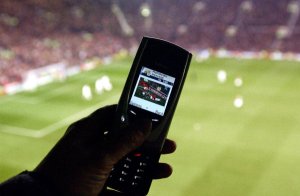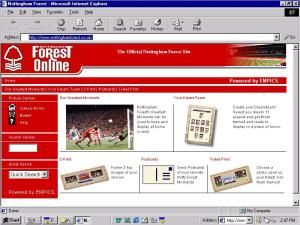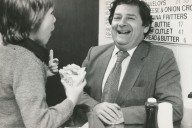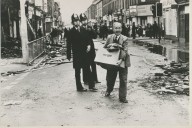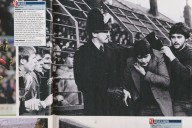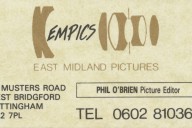
At the end of the 1990s, sports rights holders were increasingly restricting the access of photography agencies and individual sports photographers into events. The story was not a new one – up until 1972, only one photographic agency was allowed in to a cricket ground to photograph test matches. Things were looking like turning full circle.
The sale of EMPICS’ main competitor, Allsport, to Getty Images in 1997 for £30m had not helped the case for sports photography agencies. Sports rights holders wanted to only grant access to events under licence – and each year the terms became more restrictive. In many cases, the rights holder would rather not allow access at all. It was all very, very political.
We decided that our strategy must change. Up to that time, we had really just built relationships with the press officers who gave out photographer passes. We needed to work at a different level, get to know more commercial people – and make sure that if the gates were closed, we were inside a few of them.
To build these relationships, we did two things:-
1. Gave generous access to the historical archives we had acquired to undertake joint ventures with rights holders to create income from photography. We created small photo gallery/ecommerce sites that could be branded by the rights holder – with revenues shared. This used an existing asset to get a foot in the door.
2. Offer a consultancy service that brought in our experience of the photo market – along with expertise in emerging web and mobile technologies.
To undertake this, I left my role running the business (something I was not great at anyway) and effectively became the Business Development Director for the company. It was a fresh challenge – and tested all my networking skills.
The first part of the strategy worked well. We very quickly signed up a number of FA Premier League clubs, followed by Glasgow Rangers in Scotland – and then all 72 Football League clubs. Other sports followed. We started to get our name known as being “different” to other agencies. We were seen as partners and leading edge on our technology. We gave fresh thinking.
As a result of this, we were then approached by Manchester United. I was asked to meet with Ben Hatton, who was their Business Development Director. He had been brought in by Manchester United’s Chief Executive David Gill to look for new ways to generate income from media and sponsorship.
Over the next few years, I worked with Ben and Manchester United as a consultant around their photography. During that time:-
* We did a piece of work that estimated the value they would create by locking out photographers and selling their own pictures to media outlets, as opposed to the value given to Manchester United by their exposure in the printed press. Our business had always had great information systems. We were able to map our share of the market, price per picture and size of pictures used. We used this data to produce estimates of licensing revenue from pictures vs. media value compared to advertising. It was a surprise to United that the photo licensing could only produce 10% of the value created by media exposure. From that point on, they decided to have a much better relationship with photographers – and developed a new-found respect for photography. This was aided at the time by an excellent Club Photographer, John Peters – and a brilliant Head of Communications, Paddy Harverson (who went on to work with Prince Charles and the young Princes William and Harry). David Gill commissioned a media agency to corroborate our figures – and in the next negotiation for shirt sponsorship they added tens of thousands of pounds to the sponsorship fee for Vodafone.
* We then worked on whether a “category” could be created in their Partner programme for photography. We worked with Ben to create some ideas that could be exploited by potential sponsors such as Fujifilm, Kodak, Agfa, Canon, etc. We also calculated what a partnership would be worth for a photo agency as a licensing partner. We had already seen Getty undertake these sorts of arrangements with the US with NFL, NBA, etc. Manchester United brought in Fujifilm as a partner – and Getty Images paid generously to come in as photo licensing partner. Ben was delighted – I remember him telling me how we had managed to create over £1m of value for United through this exercise.
* United gave us all-area access to test out our ideas around live production of photography for mobile phones. The technology – originally called NMSP (New Media Stills Production), then latterly ShootLive – was developed at Old Trafford. We installed wireless networks from scratch – and practised using the system at Youth Team games and Reserve Matches. It helped our credibility while we pulled the technology together – and United enjoyed being leaders in the mobile space.
United were a great organisation to work with. They operated as a professional PLC in an environment that is often filled with unsavoury characters. It was a pleasure.
I went on to do similar consultancy work around photographic access, archives and mobile rights for the likes of the Football Association, UEFA and the Royal and Ancient Golf.
My last “proper job” was in 1983-5. I was a photographer at the Leicester Mercury. It was one of the most enjoyable times of my life. Working within a community, making connections, then gradually gaining trust and respect is a rewarding process.
In 1981, I started my first job after school as a Trainee Press Photographer at Mercury Press Agency in Liverpool. I’d not bargained for my first week in employment to involve the coverage of some of the worst rioting on mainland Britain. I’ll always remember the phone ringing late at night after the family had […]
I lived in a council house on the ring road in Liverpool (Queens Drive) – and had very supportive parents (although I might not have thought so at the time). I went to a Catholic Boys’ Grammar School, St Francis Xavier’s – I and was very religious (up until the moment I was 18 – […]
In 1985, I was a 22-year-old press photographer in a well-paid and rewarding job at the Leicester Mercury. I had excellent colleagues – and a very comfortable life. However, it was not enough for me – and I wanted to work for National Newspapers and create my own business. So I set out to create […]
It’s amazing how easy it is to take and send high-quality photos these days. You can pick up an iPhone, take a snap and with a couple of clicks send the image around the world. It wasn’t always that simple – here’s a tale from 1985 (just over 25 years ago) when taking and transmitting […]
